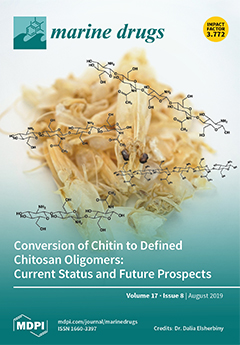Three new benzofuranoids, asperfuranoids A–C (
1–
3), two new phenylpropanoid derivatives (
6 and
7), and nine known analogues (
4,
5, and
8–
14) were isolated from the liquid substrate fermentation cultures of the
[...] Read more.
Three new benzofuranoids, asperfuranoids A–C (
1–
3), two new phenylpropanoid derivatives (
6 and
7), and nine known analogues (
4,
5, and
8–
14) were isolated from the liquid substrate fermentation cultures of the mangrove endopytic fungus
Aspergillus sp. ZJ-68. The structures of the new compounds were determined by extensive spectroscopic data interpretation. The absolute configurations of
1–
3 were assigned via the combination of Mosher’s method, and experimental and calculated electronic circular dichroism (ECD) data. Compounds
4 and
5 were a pair of enantiomers and their absolute configurations were established for the first time on the basis of their ECD spectra aided with ECD calculations. All isolated compounds (
1–
14) were evaluated for their enzyme inhibitory activity against
α-glucosidase and antibacterial activities against four pathogenic bacteria (
Staphylococcus aureus,
Escherichia coli,
Bacillus subtilis, and
Pseudomonas aeruginosa). Among them, compound
6 exhibited potent inhibitory activity against
α-glucosidase in a standard in vitro assay, with an IC
50 value of 12.4 μM, while compounds
8 and
11 showed activities against
S. aureus,
E. coli, and
B. subtilis, with MIC values in the range of 4.15 to 12.5 μg/mL.
Full article






